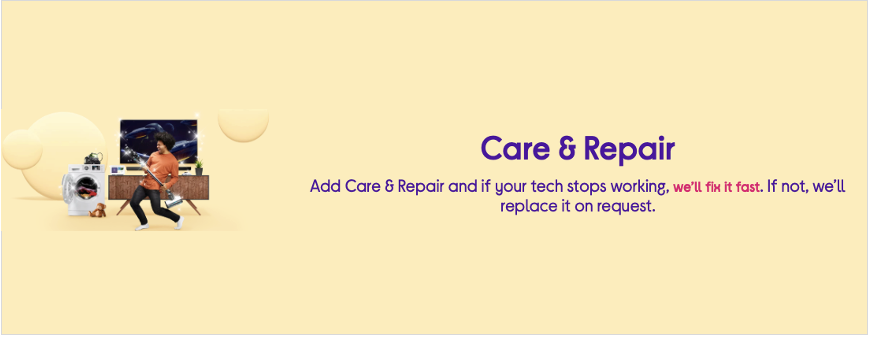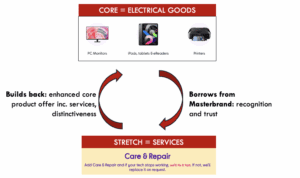An FT article on Currys turnaround grabbed my attention today (1). The electrical goods retailer reported annual sales up 3%, with pre-tax profits growing by more than 1/3. And the share price has nearly doubled since February 2024, easily outstripping its peer group. A key growth driver has been smart, strategic stretching. “Boss Alex Baldock has targeted recurring revenue, such as repair plans to accompany laptop purchases and offering in-store credit,” the FT reported.
Below, we explore the classic theory of brand stretch called “the virtuous circle” and why its theoretical brand benefits often end up being a mirage. We then use the Curry’s example to look at at a better approach to brand stretch, focused on using it to fuel growth on the core business.
1. “The Virtuous Circle” theory
The The Virtuous Circle theory of brand stretch is simple and seductive:
-
The extension borrows trust, awareness and credibility from the “Masterbrand”
-
In return, the extension builds back fresh, positive associations that improve the Masterbrand equity
And in some cases the theory does turn into practical brands growth. For example, Volvo’s XC90 SUV launch helped shift perceptions of Volvo, as we posted on here. From being all about boxy, safe saloons it evolved into a more stylish, premium brand that still stood for safety. Apple was known for desktops and laptops. But the iPhone stretched the brand into personal productivity, lifestyle and entertainment.
But for every Volvo XC90 or Apple iPhone there are plenty of examples where the theory of the virtuous circle failed to become reality …
2. The Brand Image Mirage
Many or most brand extensions fail to pay back the brand equity loan taken out from the Masterbrand. We call this the Brand Image Mirage, caused by three common problems:
A. Too Small to Matter: many extensions are small and so don’t significantly move the needle on the Masterbrand
Example: the Schweppes 1783 sub-brand was an attempt to take the Schweppes upmarket and enable the brand to compete with Fever Tree. However, the extension struggled to achieve meaningful scale and was scrapped by owner Coca-Cola
B. Too Distant: extensions can drift from what made the brand famous, leading to confusion instead of clarity.
Example: Cosmopolitan Yogurt: the fashion magazine’s extension into dairy products didn’t resonate with consumers, as the connection between a lifestyle publication and yogurt was tenuous at best.
C. Too Tactical: extensions can sometimes be short-term, tactical attempts to jump on a trend, not long-term brand builders
Example: Dunkin’ Donuts Spiked range of alcoholic beverages feels like an opportunistic attempt to tap into the trend of alcoholic soft drinks like hard seltzesrs. It’s not clear how it helps enhance the brand’s positioning as “America’s favorite all-day, everyday stop for coffee and baked goods” (3)
Which brings us back to Currys—and why their approach is smarter.

3. Brand Stretch to Grow the Core business
The best brand stretch doesn’t just borrow from the core business, it helps grow it. And it does this not just in terms of brand image but also in terms of the business model.
This is what Currys is doing with their push into services. Instead of relying purely on one-off transactions from selling electrical good, they’re building recurring revenue streams—repair plans, laptop support, in-store credit. We first posted on this push into services back in 2021 here. These services now make up 28% of their UK top line (1).
But these services aren’t just profitable—they’re core-enhancing.
-
They add value to the purchase of physical products like phones, laptops, and dishwashers.
-
They drive distinctiveness, offering a bundle competitors struggle to match.
-
They build customer stickiness, nudging shoppers to return again and again.
In conclusion, Currys’ move into services shows how strategic brand stretch can drive growth for the brand but also the core business, by enhancing the business model.


